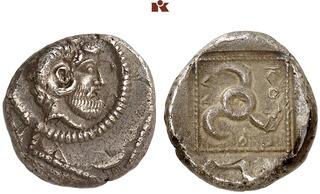| Fritz Rudolf Künker GmbH & Co. KG > Auction 402 | Auction date: 14 March 2024 |
| Lot number: 87 Price realized: 1,700 EUR (Approx. 1,851 USD) Note: Prices do not include buyer's fees. | Show similar lots on CoinArchives Find similar lots in upcoming auctions on |
| Lot description: LYCIA. Dynastische Prägungen. Kuprilli AR-Tetrobol, 470/440 v. Chr., unbestimmte Münzstätte; 2,64 g. Kopf des Zeus-Ammon r.//In Incusum: Perlquadrat, darin Triskelis. Müseler IV, 53 (dies Exemplar). RR Überprägungsspuren, Avers dezentriert, sehr schön Exemplar der Auktion Bankhaus Aufhäuser 6, München 1989, Nr. 193 und der Sammlung T. Reuter, Auktion Peus Nachf. 360, Frankfurt am Main 1999, Nr. 46. Die Übernahme des Zeus Ammon von Kyrene könnte auf Handelskontakte der Dynasten mit Nordafrika (Ägypten und Libyen) hinweisen, aber auch auf einen Rückgriff auf das Musterbuch eines Stempelschneiders. Der an seinen Widderhörnern erkennbare Zeus Ammon ist ursprünglich kein griechischer, sondern ein ägyptischer Gott. Um die 11. Dynastie (Ende des 3. Jts.) stieg der Lokalgott Amun zum führenden Gott des ägyptischen Gaus von Theben auf. Später wurde er als Göttervater verehrt und einer der bedeutendsten Reichsgötter Ägyptens. In der Oase Siwa – im Grenzgebiet zwischen Ägypten und Libyen – wurde Amun als widderköpfiger Gott verehrt, der Orakel gab. Die Griechen, die um 640 v. Chr. Kyrene gründeten, nahmen diesen Gott in ihre Stadt auf und identifizierten ihn mit Zeus. Die Kyrenäer stellten Zeus Ammon, wie sie ihn nannten, menschengestaltig dar. An seine Herkunft erinnerten nur noch die Widderhörner, die aus seinen Schläfen herauswachsen (Kraay 1976, 270; Montanmari 2016). [JN] The adoption of Zeus Ammon of Cyrene could point to trade contacts between the Lycian dynasts and North Africa (Egypt and Libya), but also to a recourse to the pattern book of a stamp cutter. The Zeus Ammon, recognisable by his ram's horns, was originally not a Greek but an Egyptian god. Around the 11th dynasty (end of the 3rd cent.), the local god Amun rose to the leading god of the Egyptian province of Thebes. He was later worshipped as the father of the gods and became one of the most important gods of the Egyptian kingdom. In the Siwa Oasis - on the border between Egypt and Libya - Amun was worshipped as a ram-headed god who gave oracles. The Greeks, who founded Cyrene around 640 BC, incorporated this god into their city pantheon and identified him with Zeus. The Cyreneans depicted Zeus Ammon, as they called him, in human shape. The only reminder of his origins were the ram's horns growing out of his temples (Kraay 1976, 270; Montanmari 2016). [JN] Estimate: 500 EUR |  |



